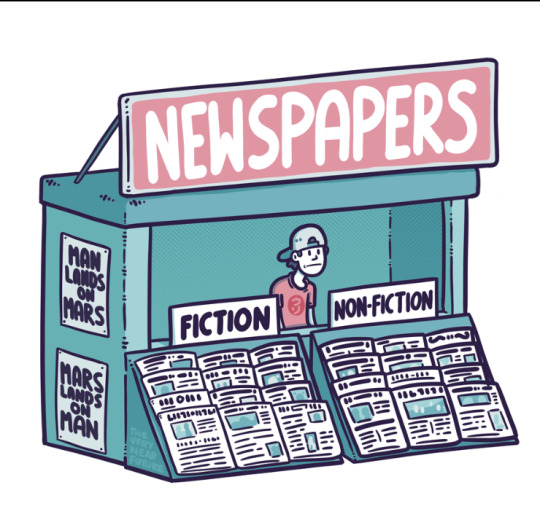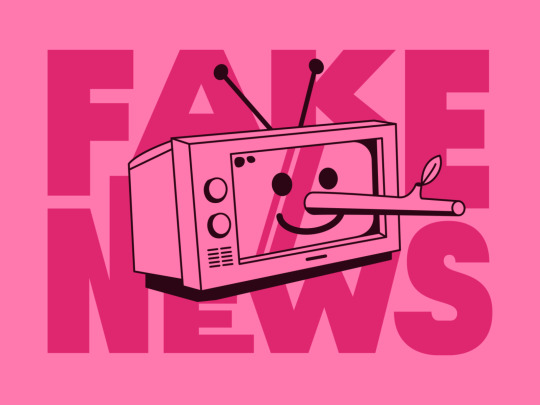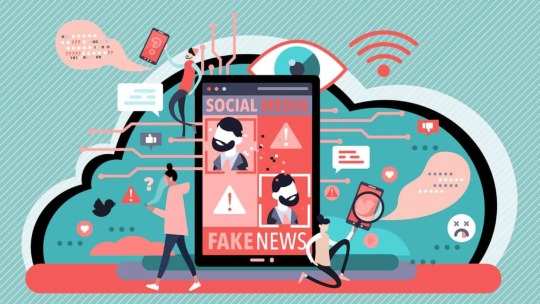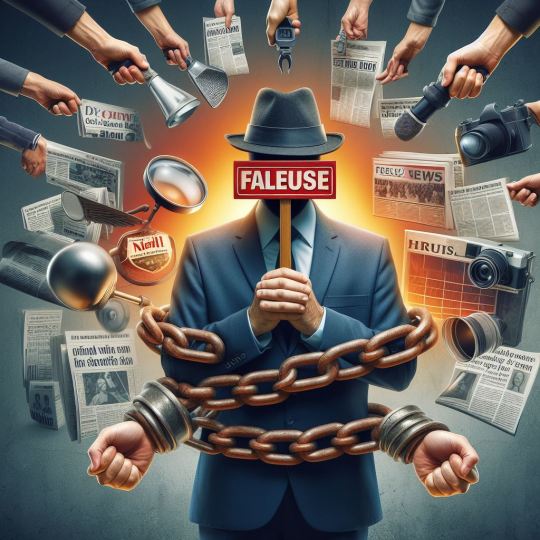#MediaLiteracy
Text
The Double-Edged Sword of Social Media: Fake News and Propaganda in Activism and Protests
How might fake news and propaganda factor into the use of social media for activists and protesters (e.g. 5G technology causing COVID-19, US's anti-lockdown protests, Trump using the term 'Chinese virus')?
#Week6 #MDA20009
Introduction
In the digital age, social media has become a powerful tool for activists and protestors to amplify their voices and organize movements. However, this newfound power comes with a downside - the proliferation of fake news and propaganda. In this blog post, we'll explore how misinformation impacts social causes. with exampleds ranging from 5G conspiracy theories to anti-lockdown protests and the controversial term 'Chinese Virus'.

The Weaponization of Fake News
A Threat to Truth & Activism
Fake news is like a stealthy infiltrator in the realm of activism, posing a sever threat to both truth and the effectiveness if social movements. Misinformation, often disguised as credible information, can quietly seep into the discourse of activists, sowing seeds of doubt and discord. It not only blurs the lines between fact and fiction but also breeds confusion within the ranks of those striving for change. Social media platforms, the very tools that empower activists to reach vast audiences, paradoxically accelerate the spread of fake news, making it a formidable adversary. In this digital age, being aware of the menace is crucial, as it can create the foundations of genuine activism and compromise the pursuit of justice (Tong et.al 2020) (George, Gerhart & Torres 2022).

The 5G-COVID-19 Conspiracy Theory
A Viral Falsehood
One Glaring example of the potency of fake news on social media is the baseless 5G technology and COVID-19 conspiracy theory. This unfounded idea erroneously posited that 5G technology was somehow responsible for the global pandemic. Fuelled by sensationalism and shared relentlessly on platforms like Twitter and Facebook, these false claims gained alarming traction. The rapid spread of this misinformation showcased the power of social media in amplifying unverified narratives. This episode underscores the critical importance of nurturing critical thinking and robust fact-checking habits, serving as a stark reminder that in the digital age, discerning truth from fiction is a responsibility we all bear (Ahmed et.al 2020).

Anti-Lockdown Protests: A Breeding Ground for Misinformation
Protests in the Age of Misinformation
The anti-lockdown protests vividly illustrate the impact of fake news and propaganda in shaping real-world events. Social media played a pivotal role in not only mobilizing these protests but also disseminating misleading information about the pandemic. Misguided claims about the virus' severity, lockdown measures, and their economic consequences galvanized protestors. However, these gatherings, fuelled by misinformation, often ignored the health risks and undermined collective efforts to curb the virus' spread. The potential consequences of such protests are dire, as they can lead to increase infections, overwhelm healthcare systems, and prolong the very restrictions they sought to oppose, demonstrating how misinformation can fuel misguided activists (Ozduzen, Ozgul & Ianosev 2023).

The 'Chinese Virus' Terminology
The Power of Language in Activism
The controversy surrounding the term 'Chinese virus,' notably used by former President Trump, underscores the potent role of language as a propaganda tool. Such rhetoric can stigmatize and perpetuate discrimination against Asian communities. By labelling the virus in this manner, it subtly shifted blame and fuelled xenophobic sentiments, casting a shadow over global perceptions. Language, in activism, wields immense influence; it can unite or divide, empower or oppress. In this case, it underscored the need for responsible and inclusive language in social justice movements, emphasizing how words can shape narratives and perceptions, both locally and on a global scale (Kania 2022) (Darling-Hammond 2020).

Combining Misinformation in Activism
The Need for Media Literacy
To combat misinformation, activists must embrace media literacy. Encourage critical thinking, fact-checking, and responsible sharing on social media platforms. Point them toward organizations and resources like Snopes, FactCheck.org, and MediaWise, which empower individuals with the skills needed to navigate today's information landscape wisely (Adjin-Tettey 2022).

Conclusion
In the digital age, where social media serves as both a catalyst for activism and a breeding ground for misinformation, the nexus of truth and advocacy is at stake. Fake news, propaganda, and divisive language can undermine the very causes activists hold dear. From the 5G-COVID-19 conspiracy to anti-lockdown protests and the 'Chinese virus' controversy, the lessons are clear. We must fortify ourselves with media literacy, critical thinking, and fact-checking to discern fact from fiction. By doing so, we can ensure that our activism remains grounded in truth and empathy, amplifying voices for change while safeguarding the integrity of the causes we champion.

References
Adjin-Tettey, TD 2022, 'Combining fake news, disinformation, and misinformation: Experimental evidence for media literacy education', Cogent Arts & Humanities, vol. 9 no. 1, viewed 10 October 2023, <https://www.tandfonline.com/doi/full/10.1080/23311983.2022.2037229>.
Ahmed, W, Vidal-Alaball, J, Downing, J & Segul, FL, 'COVID-19 and the 5G conspiracy theory: Social network analysis of Twitter data', J Med Internet Res, vol. 22, no. 5, viewed 10 October 2023, <https://www.ncbi.nlm.nih.gov/pmc/articles/PMC7205032/>.
Darling-Hammond, S, Michael, EK, Allen, AM, Chae, DH, Thomas, MD, Nouyen, TT, Mujahid, MM & Johnson, RC 2020, 'After the Chinese Virus went viral: Racially charged coronavirus coverage and trends in bias against Asian Americans', Health Educ Behav, vol. 47, no. 6, viewed 10 October 2023, <https://www.ncbi.nlm.nih.gov/pmc/articles/PMC7488172/>.
George, J, Gerhart, N & Torres, R 2022, 'Uncovering the truth about fake news: A research model grounded in multi-disciplinary literature', Journal of Management Information Systems, vol. 38, no. 4, viewed 10 October 2023, <https://www.tandfonline.com/doi/full/10.1080/07421222.2021.1990608>.
Kania, U 2022, 'Snake flu, killer bug, and Chinese virus: A corpus-assisted critical discourse analysis of lexical choices in early UK press coverage of the COVID-19 pandemic', 10 November, viewed 10 October 2023, <https://pubmed.ncbi.nlm.nih.gov/36483982/>.
Ozduzen, O, Ozgul, BA & Ianosev, B 2023, 'Institutions of governance are all corrupted: anti-political collective identity of anti-lockdown protests in digital and physical spaces', Social Movement Studies, 23 August, viewed 10 October 2023, <https://www.tandfonline.com/doi/full/10.1080/14742837.2023.2246920>.
Tong, C, Gill, H, Li, J, Valenzuela, S & Rojas, H 2020, 'Fae news is anything: They say! - Conceptualization and weaponization of fake news among the American public', Mass Communication and Society, vol. 23, no. 5, viewed 10 October 2023, <https://www.tandfonline.com/doi/abs/10.1080/15205436.2020.1789661>.
3 notes
·
View notes
Text
Evolution of News Articles: Navigating the Shifting Tides of Journalism
Introduction:
The landscape of news reporting has undergone a profound transformation since its inception, adapting to the dynamic currents of societal, technological, and cultural changes. This evolution has brought forth both positive and negative aspects that shape the way we consume and understand the news. In this blog post, we will delve into the historical progression of news articles, comparing and contrasting the strengths and weaknesses that have emerged over the years.
Early Years: The Birth of News Articles
In the early days of journalism, news articles were primarily delivered through print newspapers. Information was curated meticulously, and stories were crafted with a focus on accuracy and depth. The positive aspect of this era lies in the meticulous fact-checking and investigative journalism that characterized many newsrooms, ensuring a reliable and trustworthy source of information for the public.
Negatively, however, the accessibility of news was limited to those who could afford newspapers, creating information disparities among different socioeconomic groups. Additionally, news dissemination was relatively slow compared to the instantaneous nature of today's digital age.
The Digital Revolution: Positives and Negatives
The advent of the internet and digital technology brought about a seismic shift in the way news is produced and consumed. Positively, this era democratized information, making news articles accessible to a global audience. Online platforms allowed for real-time updates and multimedia integration, enhancing the overall reader experience.
However, the digital age also introduced challenges. The speed at which news travels can compromise accuracy, as the race to break stories often precedes thorough fact-checking. The rise of clickbait and sensationalism emerged as a negative consequence, as media outlets vied for attention in a crowded digital space.
Citizen Journalism and Social Media: A Double-Edged Sword
The rise of citizen journalism and social media platforms has further transformed the news landscape. On the positive side, it has empowered individuals to participate in news reporting, diversifying perspectives and uncovering stories that traditional media might overlook.
Conversely, the lack of editorial oversight in citizen journalism can lead to the dissemination of misinformation. Social media algorithms, designed to prioritize engagement, may exacerbate filter bubbles, reinforcing existing beliefs and limiting exposure to diverse viewpoints.
Current Challenges: Deepfakes, Misinformation, and Polarization
In the present day, the news landscape grapples with emerging challenges like deepfakes, sophisticated misinformation campaigns, and increasing polarization. These issues have the potential to erode public trust in the media and contribute to a fractured information environment.
Conclusion:
The evolution of news articles reflects the ever-changing nature of society and technology. While the accessibility and immediacy of information in the digital age are undeniably positive aspects, challenges such as misinformation, sensationalism, and polarization underscore the need for a discerning and media-literate public.
As we navigate the complexities of the contemporary news ecosystem, it becomes crucial to recognize the strengths and weaknesses of each era. Striking a balance between speed and accuracy, embracing diverse perspectives, and promoting media literacy are essential steps toward fostering a healthier and more informed society in the evolving landscape of news reporting.
#philosophy#epistemology#knowledge#learning#chatgpt#education#MediaEvolution#NewsIndustry#DigitalRevolution#JournalismHistory#CitizenJournalism#MediaLiteracy#InformationAge#FakeNews#SocialMediaImpact#Deepfakes#NewsConsumption#Sensationalism#Polarization#TruthInJournalism#MediaChallenges#DigitalNews#InformationDemocracy#TechAndNews#NewsCredibility#MediaEthics
2 notes
·
View notes
Text
Deconstructing the Message of Barbiecore
Hey there, lovely readers! Welcome back to "Fashion Fables," your go-to source for insightful commentary on fashion through a multidisciplinary lens. Today, we're delving into the fascinating world of Barbiecore, a viral fashion trend that's been making waves recently. We'll be dissecting the underlying messages of two articles that shed light on this trend: "The Long, Complicated, and Very Pink History of Barbiecore" by Cady Lang on TIME and "What Is Barbiecore? Everything to Know About the Viral Fashion Trend Inspired by Barbie" by Skyler Caruso on PEOPLE.
The Long, Complicated, and Very Pink History of Barbiecore by Cady Lang
In the article by Cady Lang on TIME, published on June 27, 2023, we are introduced to the concept of Barbiecore. Lang discusses how Barbiecore is a fashion trend inspired by the iconic Barbie doll, known for its pink hues and glamorous style. The article unravels the history of Barbie, how it evolved as a symbol of beauty standards, and how it has influenced modern fashion. Lang emphasizes that Barbiecore's resurgence signifies a shift in embracing individuality and subverting traditional notions of femininity.
What Is Barbiecore? Everything to Know About the Viral Fashion Trend Inspired by Barbie by Skyler Caruso
Skyler Caruso's article on PEOPLE, updated on July 19, 2023, further explores the Barbiecore trend. Caruso highlights the aesthetic elements of Barbiecore fashion, such as bold colors, retro-inspired outfits, and playful accessories. The article describes how social media platforms have contributed to the trend's popularity, as influencers and fashion enthusiasts share their interpretations of Barbiecore. Caruso also touches on the inclusivity aspect of Barbiecore, where individuals of all genders and body types can participate in the trend.
Identifying the Mediated Messages
It's crucial to recognize that all media messages are constructed with a creative language. In the case of these articles, the authors use language and visuals to convey the essence of the Barbiecore trend. They also present the trend in a specific light, reflecting the values and perspectives of the platforms they represent.
Deconstructing the Content
Cady Lang's article on TIME unravels the extensive history of Barbie and how it has influenced the emergence of the Barbiecore trend. It traces Barbie's evolution from her inception as a toy to her transformation into a cultural icon. This article highlights the intricate relationship between Barbie's legacy and the resurgence of pink-hued, nostalgic fashion.
Skyler Caruso's piece on PEOPLE takes a more contemporary approach, providing a comprehensive overview of the Barbiecore trend. The article breaks down the trend's key characteristics, from its emphasis on pink aesthetics to its celebration of nostalgia. It also discusses how influencers and fashion enthusiasts have embraced Barbiecore as a form of self-expression.
Both articles construct messages that celebrate the Barbiecore trend, albeit from slightly different angles. Lang's article on TIME emphasizes the historical significance of Barbie and the trend's potential to challenge beauty norms. It connects Barbiecore to a broader cultural shift towards embracing diverse forms of self-expression.
On the other hand, Caruso's article takes a more visual approach. It highlights the visual elements and accessibility of Barbiecore, catering to a younger, trend-focused audience. The inclusion of social media as a driving force behind the trend speaks to the influence of profit and power in shaping fashion trends through digital platforms.
Presenting Key Ideas
These messages can be further deconstructed as we delve into the key concepts and ideas presented in these articles:
Constructed Narrative
The construction of narratives in media plays a pivotal role in shaping how we perceive trends like Barbiecore. Both articles construct narratives around Barbiecore. In Cady Lang's TIME article, the narrative skillfully weaves together the history of Barbie, the evolution of fashion, and broader cultural shifts. By connecting Barbie's legacy with contemporary fashion, the article suggests that Barbiecore is more than just a trend – it's a culmination of decades of influence. This narrative appeals to readers' sense of nostalgia and appreciation for cultural history, positioning Barbiecore as a bridge between the past and the present.
On the other hand, Skyler Caruso's PEOPLE article takes a more immediate approach. It frames Barbiecore as a viral sensation rooted in nostalgia and self-expression, highlighting its current popularity and the way it has quickly captured the attention of fashion enthusiasts. This narrative capitalizes on the fast-paced nature of digital media and social trends, portraying Barbiecore as a trend of the moment that's reflective of current attitudes and aesthetics.
Embedded Values
Both articles subtly embed certain values associated with Barbiecore. They celebrate individuality, creativity, and the empowerment of embracing one's unique style. By spotlighting how individuals interpret and embody Barbiecore, the articles champion the idea that fashion is a form of self-expression and a way to assert one's identity.
However, there's also an inherent consumerist value that's embedded in the articles. As they discuss the popularity of Barbiecore, they indirectly promote the idea of purchasing items to fit the trend. The more attention the trend receives, the more likely it is to lead to increased sales and profits for fashion brands. This consumerist value is intricately tied to the commercial nature of the fashion industry.
Diverse Experiences
One of the fundamental principles of media literacy is recognizing that different people can experience the same media in diverse ways. Readers of these articles will likely have varying reactions to Barbiecore based on their personal backgrounds, cultural perspectives, and fashion preferences. Some might resonate with the nostalgia and find the trend empowering, as it allows them to connect with a beloved childhood icon and express themselves through fashion.
Conversely, others might perceive the trend differently. They might question whether Barbiecore perpetuates traditional gender norms due to its association with the iconic Barbie doll, known for its portrayal of femininity. Though today’s idea of Barbie and Barbiecore presents a more inclusive and empowering narrative; there are still critics who think that its just another “woke” trend. These diverse interpretations are important and we should engage in conversations that explore different viewpoints.
Profit and Power
In today's media landscape, it's evident that articles are often structured to engage readers and generate profit for media platforms. The choice of headlines, visuals, and language is carefully curated in both the articles from TIME and PEOPLE to capture attention and encourage clicks, which in turn increases ad revenue or website traffic.
As readers, it's important to be aware of how media messages are strategically designed to influence our perceptions. While the goal of these articles could be seen as to open a dialogue about Barbiecore, it is not just that, its also to maintain the financial viability of the platforms. This awareness prompts us to consume media critically, recognizing that the presentation of information could be influenced by underlying bias, motives and agendas.
. . .
By deconstructing the narratives, values, diverse experiences, and underlying profit motives of these articles, we enhance our media literacy skills. We become more adept at deciphering the complexities of media messages, developing a well-rounded understanding of trends like Barbiecore as presented in the articles, and engaging with content in a more informed and critical manner.
Wrapping It Up
In conclusion, exploring the articles about Barbiecore reminds us of the intricate interplay between fashion trends, media messages, creativity, values, and commercial interests. As fashion enthusiasts, it's essential to engage with media critically and appreciate the multifaceted nature of trends like Barbiecore. By critically analyzing and deconstructing the narratives presented in these articles we gain a richer understanding of how different sources can convey similar messages with distinct nuances. We enhance our ability to perceive the layers of meaning within the Barbiecore trend and develop a more informed perspective on the multidimensional world of fashion.
Stay tuned for more thought-provoking insights and fashion stories right here on "Fashion Fables"!
Until next time, keep rocking your unique style!
Signing Off,
Sonaxi Satpathy
Your Friendly Neighborhood Fashion Blogger
#FashionFables#Barbiecore#FashionTrends#MediaLiteracy#FashionAnalysis#BarbieInspired#StyleDiversity#SelfExpression#FashionCulture#Inclusivity#Consumerism#MediaInfluence#CulturalShifts#Nostalgia#Individuality#FashionBlogger#CreativeLanguage#FashionInsights#MediaMessages#BarbieLegacy#GenderNorms#CriticalThinking#VisualNarratives#ProfitandPower#FashionEnthusiast#TrendSpotting#FashionHistory#DigitalInfluence#SocialMediaImpact#MediaCritique
4 notes
·
View notes
Text
Examining Democratic Norms:
Analyzing Concerns Surrounding Donald Trump's Policies
In the realm of politics, no figure has been as polarizing in recent memory as Donald Trump, the 45th President of the United States. During his tenure from January 20, 2017, to January 20, 2021, his policies and leadership style elicited varied responses from the public and experts alike. While some praised his efforts, others expressed concerns over the potential erosion of democratic norms. In this blog, we will analyze some of the policies associated with Trump's administration that raised questions about authoritarian tendencies and their implications for democratic institutions.
Attacks on the Media: Preserving Press Freedom
One of the key tenets of a robust democracy is a free and independent press. Throughout his presidency, Donald Trump frequently criticized the media, particularly when faced with critical coverage. The "fake news" label became a common refrain, creating an atmosphere of hostility and mistrust towards journalists and media outlets. Critics argued that this rhetoric undermined press freedom and the role of the media as a check on government power, which is a crucial safeguard in democratic societies.
Executive Orders: Balancing Executive Power and Checks
The use of executive orders is a legitimate tool for presidents to implement policy decisions swiftly. However, Trump's administration was known for its extensive use of executive orders, sometimes bypassing Congress to enact policies. Critics expressed concerns that this approach could weaken the checks and balances system that ensures a fair distribution of power among the three branches of government. While executive orders can expedite decision-making, they should be used judiciously and in accordance with democratic principles.
Immigration Policies: Striking a Balance
Trump's approach to immigration was a central point of contention during his presidency. The "Zero Tolerance" policy, which led to the separation of families at the border, sparked significant outcry and accusations of inhumanity. Critics argued that it prioritized border control over humanitarian considerations and raised questions about how democratic societies should balance border security and compassion.
Rhetoric and Division: Fostering Unity and Inclusivity
Trump's rhetoric often targeted specific ethnic and religious groups, and his language against political opponents and critics was at times inflammatory. Critics pointed out that such divisive rhetoric could exacerbate social divisions and undermine national unity. In democratic societies, leaders are expected to foster inclusive dialogue and promote a sense of unity among citizens, regardless of their political affiliations.
Pardons and Self-Pardoning: Upholding the Rule of Law
The presidential pardon power is an essential element of the U.S. Constitution, allowing presidents to grant clemency to individuals convicted of federal crimes. However, some of Trump's controversial pardons raised questions about the potential abuse of this power for political purposes. Additionally, discussions about the possibility of self-pardoning raised concerns about the limits of executive authority and the need to uphold the rule of law.
The Trump presidency was a tumultuous period in American politics, marked by both praise and criticism. While his policies may have resonated with some, others raised valid concerns about potential threats to democratic norms. It is crucial for citizens to engage in informed and respectful discussions about the impact of political actions on democratic institutions. By upholding democratic principles, promoting inclusivity, and safeguarding freedom of the press, we can collectively strengthen our democracy and ensure that it remains a beacon of liberty and justice for all.
#DonaldTrump#Democracy#Authoritarianism#PressFreedom#ExecutiveOrders#ImmigrationPolicies#Unity#Inclusivity#Pardons#RuleOfLaw#PoliticalAnalysis#USPolitics#DemocraticInstitutions#ChecksAndBalances#FreePress#MediaLiteracy#CivicEngagement#PoliticalRhetoric#PoliticalDivisions#PresidentialPowers#USPresidency#PublicDiscourse#PoliticalPolarization#HumanitarianConsiderations#USGovernment#PoliticalAccountability#USDemocracy#Populism#SocialIssues#NationalIdentity
5 notes
·
View notes
Note
Vrains is harmless? The show that said you can get over PTSD if someone tells you to man up? The show that said women deserve to be violated and tortured for standing up for themselves? The show that said in the end, suicide really was the answer? But of course, you can’t stop criticizing Go Rush, where the protagonist is an immigrant and the women have agency.

In all seriousness, please go outside and touch grass. You're clearly inventing an Ark that doesn't exist.
That said...

PTSD and Manning Up
If you mean Soulburner, he and Flame found a way past it, some people are able to process and move on from PTSD, some aren't, some people are able to confront and resolve traumas best by exposure (exposure therapy is a thing but yes I realize this wasn't therapy).
I dunno man, I found Soulburner meming on Blood Shepard to be funny as heck.
Women Being Violated
If you mean Blue Angel, she wasn't the sole character to get bounced, a huge point between her, Go and Soulburner is they were chasing heroics and play acting being the hero, and a huge theme of VRAINS is heroism is a dangerous attitude to have. That having a savior complex is dangerous. That life isn't quite that simple and clean cut.
That people will die and get hurt and suffer badly because of it.
(I have argued multiple times Aoi should of gotten to save Miyu even if it was against Bitchy Dominatrix Sexbot Miyu)
Suicide
Mmmm, the whole point in the ending is the whole set of affairs started by Lightning was classic Greek Tragedy? Ai WANTED any other answer than to kill himself and just walk off into the sunset and be with Yusaku.
It's not saying Suicide is always the answer, it's VRAINS commenting on its focus on fate, destiny and the chain of karma and inevitability, that Ai would cause the end of the world because the last person that meant anything to him emotionally would die to protect him, removing his last chain of sanity.
I think that makes his whole arc, you know, actually interesting, that we have a hero who doesn't want to do wrong, but his own positive traits are tragically what are making him suffer.
Like. That's actually interesting writing?
He's faced with the apocalypse, death, ego death and giving birth to a race of AI, or gay marriage. And that's actually, I dunno, I think it's good writing. You've given a character a tragedy and no real easy answer.
Go Rush!!
I dunno man, I like Yudias, I like the women in the show.
I just think the end of the second arc was poorly managed/rushed feeling and Rovian wasn't given any actual motivations/clear chain of logic to oppose THE LUGH. Which I've said are probably victims of Yudias' actor getting COVID.
I'm critical because I think the rest of the show is pretty good (a little weaker than SEVENS outside of SEVENS' last arc), and it disappoints me that it kinda flopped with Rovian or more clearly telegraphing the Space Treasure, when the rest of the show's pretty okay to banger.
4 notes
·
View notes
Text

PragerGru
#society#political#capitalism#SocialismNow#Communism#Communist#marxism#statusquo#medialiteracy#corporate#individualism#liberal#corporatemedia#corporateparty#ClownWorld#societychallenge#jordanpeterson#MainstreamMedia#societyandculture#SocialConditioning#usa#americanmade#unitedstates#PragerU#history#capitalismkills#classwar#classwarfare#clownworld#communist
3 notes
·
View notes
Text





Nurturing Critical Thinking in Modern Times: Navigating Media Literacy and Beyond
Join us as we dive into the vitality of sharpened critical thinking in today's hyperconnected era, exploring the intersection of media literacy, crime and punishment, and broader implications across disciplines. Follow along as we investigate sources, decipher facts from fallacies, and construct balanced viewpoints, emboldening ourselves to tackle pressing matters shaping society and daily lives.
1 note
·
View note
Text
Analysis of: "Our Trump reporting upsets some readers, but there aren’t two sides to facts: Letter from the Editor" (cleveland.com, 30. March 2024)
Here is a summary of the key points from the discussion:
The document is an editorial/opinion piece written by the editor of Cleveland.com defending their Trump coverage.
It acknowledges criticims from pro-Trump readers but says the priority is reporting facts over validation.
Facts show Trump undermined elections and sparked an insurrection in an unprecedented attack on democracy.
Equating Trump and Biden is a "false equivalency" as Biden did not threaten institutions like Trump.
It compares those denying Trump facts to pre-WW2 propagandists enabling Hitler's rise.
Stakeholders impacted include readers on both sides, staff, the outlet's reputation and image.
The situation reflects challenges of objective reporting in a polarized climate with no consensus on facts.
The position advocates democratic ideals like fact-based journalism over partisan alignment or propaganda.
Insights expressed include prioritizing integrity over pleasing all; countering misinformation despite polarization; avoiding false equivalences; and lessons from history on threats to democracy.
Maintaining factual accuracy and accountability is seen as important even if it further divides or offends some part of the audience.
Genre
Based on its content and structure, this document appears to be an editorial or opinion piece written by the editor of the Cleveland.com news website. Some key evidence that points to it being an editorial/opinion piece:
It is presented as a "Letter from the Editor" which is a common way for editors to write opinion pieces sharing their views on issues.
The writing takes a clear point of view in defending the news outlet's coverage of Trump and arguing their priority is truth over validating all reader views. This subjective stance is typical of editorials.
It directly addresses criticism the editor has received from some readers, and tries to explain the rationale for their reporting approach on a controversial political figure. This makes it more of an opinion than objective news reporting.
Stylistically, it uses some elements of argumentation and analogy (comparing to Hitler's rise) to persuasively make its case, rather than just stating facts. This opinion-based style situates it as an editorial.
It runs under the Opinion section of the website, further indicating it expresses the editor's subjective view rather than neutral, objective journalism.
So in summary, the genre of this document would clearly be categorized as an editorial or opinion piece written by the news outlet's editor to the readership.
Summary
The editor has received emails from readers questioning why the news outlet treats Donald Trump differently than other politicians. Some say Trump's supporters are demeaned.
The editor acknowledges it's a difficult issue to address without offending readers who support Trump.
The editor says the news outlet's priority is reporting the truth, even if it offends some readers.
The facts show Trump undermined election faith with his false claims, and sparked the January 6th insurrection to overturn the election results. This was an unprecedented attack on US democracy.
The editor says they cannot pretend the facts surrounding Trump are unclear or that there are "two sides," as some claim.
Equating Trump and Biden is a "false equivalency" as Biden has not threatened democracy like Trump did.
The editor draws parallels between those who deny the truth about Trump and Hitler's rise, noting some denied truths to gain power, like those still denying Jan 6.
The news outlet will continue reporting truths about Trump despite offending some readers, as truth is their priority over making everyone feel validated.
Main stakeholders
Here are the main stakeholders affected by this editorial document and an evaluation of how they may be affected:
Readers who support Trump - The document directly acknowledges their criticism and likely seeks to further upset some with its explicit defense of the outlet's Trump coverage as fact-based. It may solidify their distrust.
Readers who don't support Trump - Likely validated to see the editor so strongly dismiss "both sides" arguments and pledge continued fact-based reporting on Trump's unprecedented anti-democratic acts. May boost their trust in the outlet.
Editorial staff - The editor is defending their editorial choices and policies to the readership at large. Seeks to justify practices and provide transparency to bolster credibility internally.
News outlet (Cleveland.com) - Takes a clear public stance that may further polarize some readers but arguably strengthens the brand by pledging commitment to truthful, non-partisan journalism over making every side feel heard.
Politicians who deny Jan. 6 truth - Implicitly criticizes their promotion of misinformation by comparing to pre-WWII propagandists. May damage relationship with those figures.
General public - Aims to model responsible, fact-based journalism during polarized times. Could influence public discourse if perspective spreads. But risks of further entrenching "both sides."
So in evaluating stakeholders, it both openly defends the outlet internally while potentially further dividing external audiences along partisan lines through its direct, strong defenses of coverage.
The situation
Here is an evaluation of the situation described in the document:
Political polarization in the U.S. is extremely high, particularly around Donald Trump. His claims of election fraud further divided the public.
As a news outlet, Cleveland.com is caught in this polarization. They are receiving criticism from both Trump supporters who want more flattering coverage, and opponents who feel they don't go far enough in countering misinformation.
The editor acknowledges this is a nuanced issue without a clear consensus view. Accommodating all perspectives risks validating factually incorrect claims.
Key facts about Trump's actions, such as sparking the insurrection on Jan. 6, are unambiguous according to the editor. However, some politicians and parts of the public deny these facts.
Attempting to portray all sides as equally valid on this issue would undermine the outlet's integrity and responsibility to truthful reporting. Clarity is needed on clear factual matters.
Yet taking a strong stance also risks further polarizing readers and damaging important relationships. Nuance is difficult amid intense partisanship.
The media landscape has become more partisan, making consensus on facts more elusive - a trend the editor implicitly warns could undermine democracy as it did in 1930s Germany.
Overall, this situation reflects the considerable challenges facing mainstream journalism in providing factual, principled coverage during a hyper-polarized political climate with no agreement on basic facts among the public. It is a complex issue without an easy or consensus-based solution.
Culture of enlightenment
Here is an evaluation of the situation described in the document in relation to the culture of enlightenment:
A key principle of the enlightenment is the pursuit of objective truth and facts over rhetoric, partisanship or appeals to emotion/authority. This aligns with the editor's focus on factual reporting.
Enlightenment thinkers believed the spread of reasoned debate and a free exchange of ideas would help societies progress. However, the polarization described makes consensus on facts difficult.
The editor draws on evidence and analogical reasoning (comparing to 1930s Germany) to make the case for their approach, reflecting an enlightenment emphasis on reasoned argument over unsupported assertions.
Defending an independent press committed to truth rather than serving political interests echoes enlightenment views on an uncensored flow of information.
However, the tribalism and "alternate facts" phenomenons described diverge from enlightenment ideals of a rational public assessment of ideas/information.
While aiming to uphold enlightenment principles of factual reporting, the situation suggests those principles are increasingly challenging to apply in some modern contexts.
Overall, the editor's position advocates for core enlightenment goals like truth, evidence-based reasoning and an uncensored press. However, the polarized social/media conditions depicted diverge significantly from enlightenment ideals of a well-informed, cohesive public assessment of ideas. It reflects both promise and limitations of those ideals in today's world.
Position of the ideas
Based on the ideas presented in the document, I would evaluate the position as being more democratic than autocratic:
Democratic elements:
Upholds commitment to factual, truthful reporting even when it offends some partisan views. Truth is a core democratic virtue.
Defends the outlet's independence and role in holding politicians accountable, rather than being a mouthpiece for any side.
Explicitly rejects false equivalencies that aim to portray all sides as equally valid when facts clearly show one side is misleading.
Draws a direct line between denying factual truths about threats to democracy and the rise of autocratic regimes.
Autocratic elements:
Could be seen as taking a partisan stance in strongly defending coverage of one controversial figure over others. However, focuses on factual reporting.
Does not adequately validate the views of readers who support Trump, but their views are not presented as factual.
Overall, the position comes down strongly on the side of factual journalism, accountability, and rejection of propaganda - core democratic virtues. While it may dissatisfy some partisan views, it defends an independent press rather than alignment with any political faction. So on balance, I would evaluate the position as leaning more democratic in its expressed ideals and priorities.
Wisdom / Insights
Here are some of the wisdom/insights expressed in the document:
Journalistic integrity requires commitment to factual truth over pleasing all readers/interests. While difficult, factual accuracy is paramount.
Extreme political polarization makes consensus on facts elusive, but media shouldn't abandon pursuit of verifiable truths or enable alternative facts.
False equivalencies between political opponents can undermine accountability and spread of misinformation if facts don't support an equivalence.
History shows how tolerance of propaganda enabled authoritarian regimes; media must counter false narratives that erode democratic institutions/processes.
Partisan interests may lead some to deny clear realities even if it damages credibility or democratic discourse long-term. Short-term gains take priority.
Nuanced discussions are hard to have amid intense polarization, but abandoning nuance for absolutism can further divide rather than reconcile differences.
Readers shouldn't blindly trust any authority, as even leaders can propagate misinformation to suit interests. Independent verification is important.
Overall, the document expresses wisdom in emphasizing factual accuracy and accountability in journalism even during polarized times. It acknowledges trade-offs but suggests the risks of embracing relativism or partisanship. Maintaining integrity and countering anti-democratic narratives deserves priority per the analysis. The lessons from history also provide validation and cautionary guidance.
#FactsMatter#JournalisticIntegrity#DemocracyOverPartisanship#NeverAgain#MediaBias#ElectionIntegrity#January6th#MAGA#BidenCrimeFamily#ChecksAndBalances#MediaLiteracy#PolarizationNation#accountability#Analysis
0 notes
Text
Infographics
Media literacy in ICT requires a blend of skills: Evaluate content for credibility, employ analytical thinking to dissect information, foster understanding of diverse perspectives, and apply critical reasoning to navigate the digital landscape effectively. These competencies empower individuals to decipher, engage with, and contribute responsibly to the ever-evolving world of information and communication technology.

0 notes
Text
Immigration - 5 Key Literacies To Master
In today's world, five essential literacies are crucial for meaningful engagement with any environment that you find yourself...
As a new immigrant, you are likely to encounter a lot of captivating stories about your new surroundings. While some narratives are shared with the genuine intention of helping you navigate this unfamiliar terrain, others may be misleading and driven by less noble motives.
A widespread misconception is the belief that “Americans do not have a culture.” This is thoroughly incorrect and is…

View On WordPress
#CulturalLiteracy#DigitalLiteracy#FinancialLiteracy#GlobalCitizenship#immigrant#immigration#InformationLiteracy#MediaLiteracy
0 notes
Text
UN Special Rapporteur Applauds Philippine Human Rights Drive

Strengthening the Pillars of Democracy
In a remarkable acknowledgment of the Philippines' dedication to human rights, United Nations Special Rapporteur for Freedom of Opinion and Expression, Irene Khan, commended the nation's steadfast commitment. During a lecture in Manila, Khan celebrated the vibrant and bold nature of the Philippine press. Additionally, she praised the country's long-standing advocacy for human rights principles.
A Historic Commitment Recognized
The Philippines' Legacy in Human Rights
Khan's observations were shared during her participation in an event hosted by the Presidential Task Force on Media Security (PTFoMS) and Ateneo Law School. She recognized the Philippines as a key contributor to the Universal Declaration of Human Rights and praised its historic efforts in championing these values on a global stage.
The Challenges of Today's Media Landscape
The lecture, which drew the attention of a wide audience, including students and legal professionals, addressed the evolution of human rights and the current challenges facing journalists. In addition, the dangers of disinformation and the crucial need for media literacy were highlighted as key areas that require vigilant attention and action.
Engaging Discussions and Solutions
Addressing Contemporary Human Rights Issues
Khan engaged with attendees in a series of Q&A sessions, tackling important topics such as the limits of critiquing public officials, the state's role in safeguarding citizen rights, and the importance of independent oversight. The discourse also touched upon the issue of red-tagging, with Khan noting the Marcos administration's stance against it being an official policy, while also emphasizing the international legal framework against incitement to violence or hate.
The Role of Individuals and States in Human Rights
The lecture further explored the responsibilities of states and individuals in the realm of international human rights, underscoring the importance of mutual accountability and vigilance against human rights abuses.
A Foundation for a Better Society
Upholding Freedom of Opinion and Expression
Khan's visit and discussions in Manila underscore the critical importance of freedom of opinion and expression as fundamental components of a healthy democracy. Furthermore, by fostering an informed and participatory society, the Philippines reaffirms its unwavering commitment to these essential principles.
The government reaffirmed its dedication to engaging in constructive dialogue and ensuring the protection of these rights, reflecting a collective effort towards building a more equitable and just society.
Sources: THX News & Philippine News Agency.
Read the full article
#BoldPhilippinepress#Democracyandhumanrights#Disinformationchallenges#FreedomofOpinionandExpression#Governmentcommitmenttohumanrights#internationalhumanrightslaw#Medialiteracy#Philippinehumanrights#Red-taggingissue#UnitedNationsSpecialRapporteur
0 notes
Text
BBC Verify
Introduction: Accusations of fake news have become prevalent in today's media landscape, with even well-established organizations facing scrutiny. Recently, some voices have accused BBC Verify of being a peddler of misinformation. In this post, we will delve into the allegations and explore the credibility of such claims.
Background on BBC Verify:
BBC Verify is a platform designed to fact-check information and counter the spread of misinformation. As part of the BBC, it is held to high journalistic standards and aims to provide accurate and unbiased information to the public. However, like any organisation, it is not immune to criticism.

Claims of Fake News:
Critics argue that BBC Verify has, at times, misinterpreted or selectively presented information to fit a particular narrative. Accusations range from biased fact-checking to outright dissemination of false information. It is crucial to examine specific instances and context to better understand the validity of these claims.
Case Studies:
To substantiate allegations against BBC Verify, skeptics often point to specific cases where fact-checking outcomes were deemed questionable. However, it is essential to scrutinize these cases individually, considering the complexity of information and the challenges associated with fact-checking in real-time.
Analyzing Credibility:
While no organization is infallible, the BBC, including BBC Verify, maintains a reputation for journalistic integrity. They have editorial guidelines and a commitment to accuracy. It is vital to weigh any claims against the overall track record of the organization, considering the vast amount of information they handle daily.
Media Literacy and Critical Thinking:
In the age of information overload, media consumers play a crucial role in discerning fact from fiction. It is imperative for individuals to cultivate media literacy skills, cross-reference information, and approach news with a healthy dose of skepticism. BBC Verify, like any fact-checking platform, is a tool in the broader effort to combat misinformation.
Conclusion:
While accusations of BBC Verify peddling fake news may capture attention, a nuanced examination is necessary to gauge the credibility of such claims. It is crucial to differentiate between occasional errors or disagreements in interpretation and systematic dissemination of false information. In the broader context of media landscape challenges, promoting media literacy and critical thinking remains paramount for an informed society.
#BBCVerify#FakeNews#MediaCriticism#JournalisticIntegrity#FactChecking#MediaLiteracy#InformationVerification#NewsCredibility#CriticalThinking#MediaEthics#AccuracyMatters#NewsConsumption#BBCJournalism#InformationIntegrity#MediaTransparency#Misinformation#PublicTrust#FactCheckers#MediaAnalysis#NewsVerification#today on tumblr
0 notes
Text
A Journey Through My Fashion Time Capsule
Hey there, fabulous readers! Welcome back to "Fashion Fables," the corner of the internet where we unravel the threads of style, culture, and personal stories that shape the world of fashion. Today, I'm excited to take you on a stroll down memory lane as I share a personal story that's etched in my heart like the first stroke of eyeliner. Well, they are more like little parables but nevertheless, grab your favorite beverage and get ready to join me on this nostalgic trip!
Chapter One: A Palette of Memories - My Fashion and Makeup Odyssey
Picture this: a petite little black eyeshadow palette with an array of nine or twelve shades, accompanied by two blushes and a dinky brush. It wasn't a high-end product by any means, but for a 7 or 8-year-old me, it was pure magic. This palette marked my initiation into the world of makeup. I remember pretending to be a makeup artist crafting my masterpiece even though a lot of those endeavors ended in me looking like a clown. The thrill of experimentation was unmatched, even if the quality of the makeup left much to be desired. To mini-me it was a treasure trove of limitless possibilities.
However, like all tales, mine had its share of twists. Enter my cousin, a whirlwind of energy and curiosity. One fateful day, my precious little black palette met its demise at her hands. Though I couldn't be truly angry with her, I won't lie, a pang of nostalgia still accompanies the memory of that palette's demise. It might sound trivial, but that little black palette represented my gateway into the world of cosmetics – a world that blends artistry, self-expression, and creativity. But beneath that initial sting lay a lesson that resonated throughout my fashion journey – that memories and experiences are more valuable than material possessions. My cousin unintentionally helped me understand the impermanence of things and the importance of cherishing the experience.
Chapter Two: Gajras and Lehengas & Defying Norms
Growing up in the charming coastal town of Visakhapatnam, my fashion explorations took some rather unconventional turns. No matter the occasion, whether it was a family gathering, a festive occasion, or just a random Tuesday, you could find me adorned in lehengas, donning gajras in my hair, and proudly sporting a mathamuni (forehead jewelry). Looking back, it's clear my fashion choices were a riot of color, a symphony of traditions, and an ode to my unabashed self.
I vividly remember the amused glances and raised eyebrows from relatives and friends as I sashayed in my uniquely styled ensembles. While I could sense a hint of embarrassment from my family, I was blissfully oblivious, basking in the warmth of my own authenticity.
Flash forward to today, and while I've matured, my heart still dances to the beat of that fearless little girl who wore her heart on her sleeve – or rather, on her forehead. The memories of my mom obligingly clicking photos of me in my quirky ensembles while I posed with oversized sunglasses have remained precious tokens of that vibrant period.
Chapter Three: Pink Boots and Beyond - A Footwear Love Affair
Speaking of memorable childhood fashion fancies, let's talk about boots. Boots – a timeless statement piece that's been my constant companion since childhood. I had a pair of pink boots that I absolutely adored. Ah, those pink boots that had my heart in their grip from the very moment they encased my feet! Those boots weren't just footwear; they were an extension of my personality. I strutted around in those pink boots, embodying a confidence that comes naturally to children, unburdened by societal expectations.
Remarkably, my fondness for boots has endured the test of time. The fact that this style staple has been a consistent thread in my fashion narrative brings me immense joy. These boots, with their unwavering presence, remind me of the unwavering spirit of that little girl who knew what she loved and wasn't afraid to show it to the world.
Deconstructing My Fashion Narrative
As I reflect on my journey through fashion and personal style, I can't help but weave in how different individuals interpret and connect with fashion in unique ways, reflecting their own experiences and perspectives. My early fashion choices might have been unconventional, but they helped me develop a sense of self.
Through my story, you can glimpse the embedded values present in its messaging: of authenticity, self-confidence, and celebrating one's uniqueness.
In conclusion, my journey through fashion has been a colorful tapestry woven with memories, individuality, and a pinch of media literacy. From that first eyeshadow palette to my unapologetic fashion choices, every step has added a layer to the narrative of my personal style evolution. So, whether you're a devoted fashionista or someone dipping their toes into the world of style, remember that your fashion journey is a unique expression, worthy of celebration and exploration.
Thank you for joining me on this chapter of Fashion Fables by Your Friendly Neighborhood Fashion Blogger. As we embark on this journey, I invite you to join me in unraveling the intricacies of fashion as a storytelling medium. Let's explore how fashion intertwines with identity, culture, and media, all while appreciating the power it holds to shape and reshape our narratives. Stay tuned for more captivating tales of style, culture, and personal evolution!
Until next time, keep embracing your fashion fables with frills and flair!
Signing Off,
Sonaxi Satpathy
Your Friendly Neighborhood Fashion Blogger
#FashionFables#StyleJourney#PersonalNarrative#FashionEvolution#MakeupMemories#UnconventionalFashion#AuthenticStyle#FootwearLoveAffair#MediaLiteracy#IdentityAndCulture#FashionBlogger#SelfExpression#FashionStorytelling#CherishExperiences#UniquenessCelebration#FashionandIdentity#ColorfulTapestry#FashionExploration#FashionInspiration#SignatureStyle#UnapologeticFashion#FashionFablesBySonaxi#FashionAndSelfConfidence#FashionAsArtistry#FashionCultureMedia#FashionExpression#FashionAndMemories
3 notes
·
View notes
Text
Unmasking Fake News: How Technology is Spreading Lies Online
#algorithmicamplification #anonymityoftheinternet #artificialintelligence #combatingmisinformation #criticalthinkingskills #deepfakes #educators #fakenewswebsites #individualusersofonlinecontent #machinelearningalgorithms #manipulationofvideoandaudio #medialiteracy #misinformationspreading #policymakers #socialmediaplatforms #spreadofmisinformation #techcompanies #verifyinginformationinrealtime
#Politics#algorithmicamplification#anonymityoftheinternet#artificialintelligence#combatingmisinformation#criticalthinkingskills#deepfakes#educators#fakenewswebsites#individualusersofonlinecontent#machinelearningalgorithms#manipulationofvideoandaudio#medialiteracy#misinformationspreading#policymakers#socialmediaplatforms#spreadofmisinformation#techcompanies#verifyinginformationinrealtime
0 notes
Note
Why is it up to the readers to apply suspension of disbelief when the authors could simply make their works not require it? A bit of research here and there, maybe a bit of alterations to the story to focus on the more exciting side of believability and bravo! The readers won’t have to put away their disbelief in order to enjoy the story.

Because most authors don't want to be restrained by the frail, childish, dull placid limitations of reality, Anon that rigidly. Like Detective Stories are one thing, but a Shonen Jump Supernatural Horror Action Mystery Thriller like Yu-Gi-Oh!, reality is more of a vague guideline at best.
A fair number do the research, then throw it in a rubbish bin if it doesn't suit their purposes, or simply decide to amp the story up to more absurd levels (often times to legally protect themselves). Plus a lot of people LOVE larger than life stories, and want to shoot believability in the head. They don't come to media for that al the time.
And most people are normal healthy human beings who don't hype fixate on technical minutiae or economic models when reading or watching stuff because they understand the caveats.
Like for example, Kazuki was FAR well aware what he was writing about because he was a Magic: The Gathering player. Seto Kaiba was a lampoon, a parody of a guy, he knew who had deep pockets and a lot of rare overpowered, undercosted cards, who of what I know he was on good to decent terms with but was kind of a cheeky dick.
Magic & Wizards, Duelist Kingdom, Battle City, were drawing off of his life experience as a card gamer who played Magic: The Gathering, except he was turbocharging it and simplifying the game for a 20 page weekly comic.
And readers at the time who read Yu-Gi-Oh! in the 1990s would know exactly what he's writing about. This was the era of the overpriced first edition comic book market, of the heavily overpriced, impossible to get collectibles, of the Beanie Babies being able to get you a small fortune.
Kazuki was entirely writing something that while not 100% grounded, his geekier fans within the CCG market could point to things and go:

Like an entire house? 4 copies of a card in the world? Parody, but Kazuki was making a point of the difficulty at the time of getting The Power Nine, the over inflated market of collectibles, and the lengths to which collectors would go. He was speaking to a lived experience.
2 notes
·
View notes
Text
The War of the Worlds Broadcast: Panic and Media Revolution
On October 30, 1938, a seemingly ordinary Sunday evening turned into a night of mass panic and hysteria. Orson Welles and his Mercury Theatre on the Air had just performed a radio adaptation of H.G. Wells’ novel, “The War of the Worlds,” and what followed would become one of the most remarkable chapters in the history of media and public reaction.
The Background: A Fictional Invasion Unleashed…

View On WordPress
0 notes